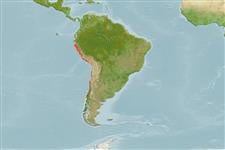Common names from other countries
Environment: milieu / climate zone / depth range / distribution range
Ecología
; rango de profundidad 0 - 500 m (Ref. 356). Tropical, preferred 20°C (Ref. 107945); 5°S - 42°S, 81°W - 70°W (Ref. 106891)
Southeast Pacific: From Paita, Peru to Chiloé, Chile. Tropical to subtropical.
Length at first maturity / Tamaño / Peso / Age
Maturity: Lm ? range ? - ? cm Max length : 12.0 cm ShL macho / no sexado; (Ref. 356)
Found in shallow bays (Ref. 106891). Inhabits sedimentary grounds in sheltered areas at depths from 5 to 40 m (Ref. 106862).
Life cycle and mating behavior
Madurez | Reproducción | Puesta | Huevos | Fecundidad | Larva
Life cycle: Embryos develop into free-swimming trocophore larvae, succeeded by the bivalve veliger, resembling a miniature clam (Ref. 833). Spawning occurs year-round but mainly during spring and autumn (Ref. 106788).
SAUP Database. 2006. (Ref. 356)
IUCN Red List Status (Ref. 130435)
CITES status (Ref. 108899)
Not Evaluated
Not Evaluated
Human uses
Pesquerías: comercial; Acuicultura: comercial
FAO - Acuicultura: producción; pesquerías: landings | FishSource | Sea Around Us
Herramientas
Fuentes de Internet
Estimates based on models
Resiliencia
Alto, población duplicada en un tiempo mínimo inferior a 15 meses (K=1.99-2.88).
Vulnerability
Low vulnerability (10 of 100).
